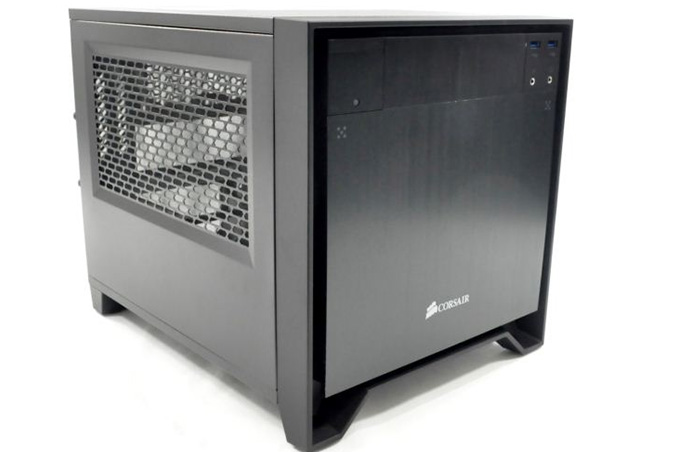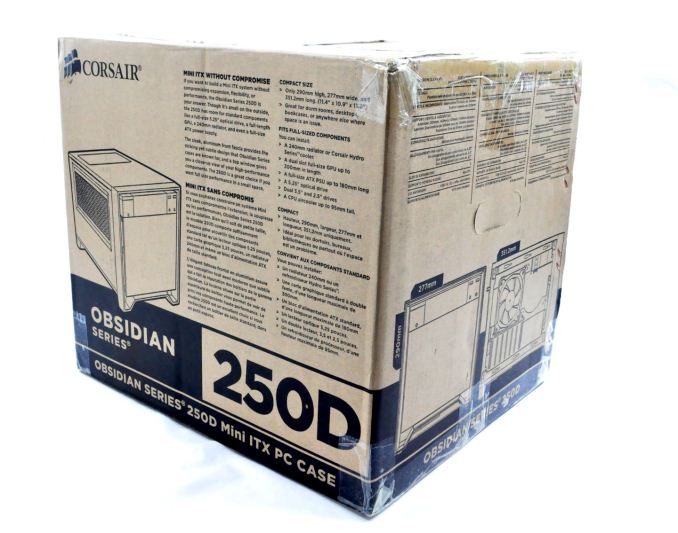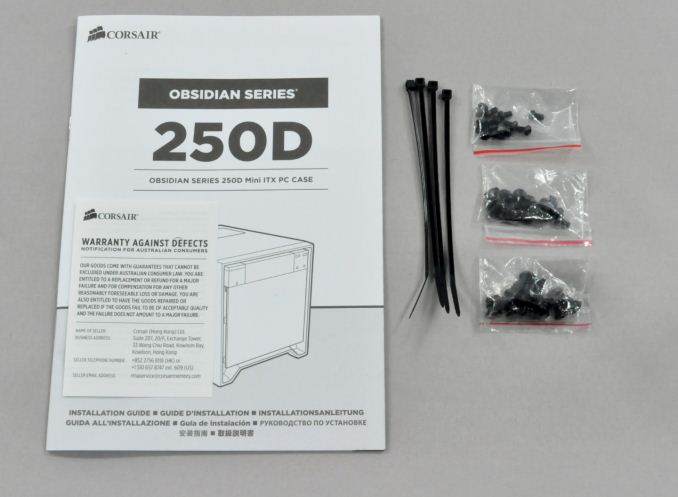Corsair Obsidian 250D Case Review
by E. Fylladitakis on January 21, 2014 12:00 PM EST- Posted in
- Cases/Cooling/PSUs
- Corsair
- Mini ITX
- Case

Ed: As this is his first review, we’d like to quickly introduce E. Fylladitakis. E. is taking over Cases & Cooling coverage as our newest editor, so this is the first of many articles you will see from him over the coming months
Corsair is a very well-known manufacturer among technology enthusiasts, and the company has been a supplier of premium memory modules for decades. During the past several years however, the company has successfully diversified into many segments of the market and today offers numerous products: computer cases, power supply units, air and liquid CPU coolers, solid-state drives, and gaming peripherals can all be found in Corsair's product ranks.
With the recent announcement of the Obsidian 250D, the company chose to start 2014 by joining the Mini ITX case fever, something most other large case designers and manufacturers have done recently. The Obsidian 250D however has not been designed with minimum proportions in mind; despite the Mini ITX format, it can still house very powerful gaming systems and advanced cooling solutions. The specifications of the case can be seen in the following table.
| Corsair Obsidian 250D | ||
| Motherboard Form Factor | Mini-ITX | |
| Drive Bays | External | 1 × 5.25" |
| Internal | 2 ×2.5" 2 × 3.5" | |
| Cooling | Front | 1×200 / 140 mm (140 mm included) |
| Rear | 2×80mm | |
| Top | - | |
| Side | 2 x 120 mm (1 × 120 mm included) | |
| Bottom | - | |
| I/O Port | 2x USB 3.0, 1x Headphone, 1x Mic | |
| Power Supply Size | ATX | |
| Clearances | HSF | ≈145 mm |
| PSU | - | |
| GPU | ≈295 mm | |
| Dimensions | 350 mm ×277 mm ×290 mm(D × W × H) | |
| Weight | ≈5kg | |
| Prominent Features | Aluminum front fascia and thick steel construction Top window for component visibility Thumbscrew backplate removal for PSU and hard drive access Easily removed dust filters on all intakes Simultaneously fit two 3.5”/2.5” drives, two 2.5” drives, one 5.25” drive, a full sized PSU, a 290mm long GPU, and a 240mm radiator Innovative three panel removal for sides and top panel, with thumbscrews Tons of cable routing tie downs for easy cable maintenance Tool free installation of all drives | |
| Price | ≈ 70 EUR / 89.99 USD | |
We received the Obsidian 250D inside a short, simple cardboard box that hints at the cubic shape of the case. Inside the box, we found the case packed between thick Styrofoam slabs and wrapped in a nylon bag, which is more than ample shipping protection for the small, lightweight case.
The bundle of the Obsidian 250D is sparse, with Corsair supplying only the absolutely necessary parts needed to fully assemble a system. We only found a manual, three small bags with black screws and a few black cable ties. At least some more cable ties and perhaps a couple of cable straps would be a nice addition. The bundle may be found in a cardboard box secured into one of the 3.5" trays.












52 Comments
View All Comments
E.Fyll - Tuesday, January 21, 2014 - link
There is no comparison with a real system simply because that would be entirely misleading. Testing a case with a real system is an improper procedure and can lead to greatly misleading results. Real systems are active loads and interact with their environment, which makes every single system unique. Each such system would favor some designs over others, therefore comparisons between systems would have been useless. Even if you build the same exact system, using parts from the exact same OEMs, even a different orientation of a single cooler could yield entirely different results.The synthetic load which we are using emulates the heat dissipation of a system (multiplied a few times) but does not aid the cooling capabilities of the case in any way. Therefore, we can assess the true stock thermal performance of the case, regardless of the system that will be used or any modification that the user will perform.
sleepytea - Tuesday, January 21, 2014 - link
I was really looking forward to this review, but it turned out to be a big disappointment for two reasons. First, the review format completely breaks the mold and makes no direct comparison to previous mini-itx builds. I want to see this case compared against it competitors, especially the ones that have been reviewed here in the past. The only other case mentioned is a HTPC case by silverstone which is completely irrelevant. The Sugo sg08 has an excellent review and would be a much more relevant comparison point.Second, the writing is flat and uninteresting. Dustin Sklavos has been the man for the job up to this point and I'm not sure if he is no longer on staff here, but he had a history with these mini-itx builds and the combination of his writing talent, personal interest in the form factor, and experience testing SFF builds made for excellent and trust worthy reviews.
Egg - Tuesday, January 21, 2014 - link
Corsair hired him, you can look up his twitter at @DTheSleeplesslmcd - Tuesday, January 21, 2014 - link
I was confused about Dustin's no-show, and the "About Anandtech" hasn't been updated with the info.And while the writing was flat, there's no question that we now have a new writer and Anandtech community member who I'm sure will become more personable as we batter him to bits down here ;)
thesavvymage - Tuesday, January 21, 2014 - link
according to another commenter here, corsair hired him. his twitter handle is @dthesleeplessDustin Sklavos - Wednesday, January 22, 2014 - link
Aw, it's nice to be missed. I'm still doing system reviews here and there for AT, but yeah, Corsair occupies my time now. I'm writing for their blog now and doing a lot of in-house testing, I'm also part of the development process for products you'll be seeing towards the end of this year and into next year. :)E. came highly recommended and I think once he gets situated, his voice will become more apparent. My early stuff at AT was much more formal and academic the way his is here. Frankly I think his testing methodology here is more scientific and reliable than mine was. It's good work all around that I'd only expect to improve, and he's definitely AnandTech material.
sleepytea - Wednesday, January 22, 2014 - link
That's all great to hear and I do look forward to seeing what comes from Corsair and mr. Fylladitakis in the future. Cheers!CloudFire - Tuesday, January 21, 2014 - link
I would think it'll be so awesome if you guys did video reviews of computer products on youtube similar to how Hardware Canucks does, seeing a video presentation of the review would be something I'd love to see from anandtech.spidey81 - Tuesday, January 21, 2014 - link
"Corsair created the Obsidian 250D for enthusiasts who want to create a fully featured, powerful gaming system in compact dimensions.""...installing USB 3.0 only front panel ports without providing an adapter for USB 2.0 motherboard headers is a bad call, as very few Mini-ITX motherboards have a USB 3.0 header."
I'm not sure what you're trying to say here, but after doing a quick search on the Egg for Z77/Z87 M-ITX motherboards (most likely the choice of chipset for gamers/enthusiasts aka the target audience) ALL of the 8 motherboards that came up had USB 3.0 front panel headers. Even the comparable AMD boards were equipped with them. It's only when you start entering budget and lower mainstream boards that you see USB 3.0 front header being left off. And per your quote, that's not the target audience for this case.
E.Fyll - Tuesday, January 21, 2014 - link
Indeed, per my quote, Corsair's target audience is that of gamers and enthusiasts. However, many mainstream and lower budget boards do not have an USB 3.0 header. As you said, a high performance board which has an USB 3.0 would "likely be the choice" of the target audience. That however is a hypothesis; someone could easily want to install an Asus asus c8hm70-i/hdmi and use it as a HTPC. It could become an issue for some users, therefore I had to mention it.